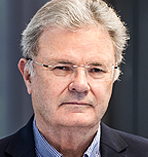Alexander Hollaender Award in Biophysics

About the Alexander Hollaender Award in Biophysics
The Alexander Hollaender Award in Biophysics is presented every three years and carries with it a $20,000 prize. The Award recognizes outstanding contributions made to the field of biophysics. Henrietta W. Hollaender established the Alexander Hollaender Award in Biophysics in honor of her husband, Alexander W. Hollaender, who brought to prominence the field of photobiology. With an interest in the lethal and mutagenic effects of monochromatic ultra-violet radiation on cells, Dr. Hollaender identified the first clear indication that changes in nucleic acids needed to be analyzed, rather than proteins.
Most Recent Recipient
 |
Wolfgang Baumeister, Max Planck Institute of Biochemistry, received the 2022 Alexander Hollaender Award in Biophysics.
Baumeister is an innovator in the field of electron microscopy. He has pioneered the development of cryogenic electron tomography that has enabled him to apply transmission electron microscopy to several areas of great biological interest, obtaining images of complex macromolecular and supramolecular assemblies at unprecedented resolution. Read more about Baumeister's work»
Watch Baumeister's acceptance speech»
Award History
The Alexander Hollaender Award in Biophysics was first awarded in 1998 to Wayne A. Hendrickson for his contributions to macromolecular crystallography, specifically his development of robust methods of phasing and refinement, and determination of complex and biologically important structures. Hendrickson is best known for his work pioneering multi-wavelength anomalous diffraction (MAD) and its use as an analytical tool for protein crystallography. Previous recipients of the Alexander Hollaender Award in Biophysics continue to achieve outstanding advancements in their fields. One recipient has received a Nobel Prize in Chemistry (Henderson 2017).
Recipients:
Wolfgang Baumeister (2022)
For his pioneering contributions in the field of cryogenic electron tomography and obtaining biological insights into large macromolecular assemblies, especially the proteasome, and proteins involved in neurodegeneration.
Read more about Baumeister's work»
Watch Baumeister's acceptance speech»
Jane S. Richardson (2019)
For her innovative contributions to assess quality and accuracy of macromolecular structures through the development of methods for the analysis, representation, and validation of atomic models. Her ribbon representations of protein structures have made them easily comprehensible by the entire scientific community.
Read more about Richardson's work
Watch Richardson's acceptance speech»
Richard Henderson (2016)
For his pioneering work in the determination of atomic structure of a macromolecule by electron microscopy (EM). Henderson determined the first atomic structure of a 2-D protein crystalline array (bacteriorhodopsin) by EM. His identifications of the key bottlenecks for obtaining high-resolution EM structures has guided subsequent efforts to revolutionize single particle cryoEM for structural biology research at the atomic level.
Read more about Henderson's work
Watch Henderson's acceptance speech»
King-Wai Yau (2013)
For innovative, rigorous, and fundamental contributions to the biophysics of sensory transduction in rod, cone, and non-image visual systems and in olfaction.
Watt W. Webb (2010)
For pioneering the applications of rigorous physical principles to the development of optical tools that have broadly impacted our ability to examine biological systems.
Barry H. Honig (2007)
For pioneering theoretical and computational studies of electrostatic interactions in biological macromolecules and of the energetics of protein folding.
Carlos J. Bustamante (2004)
For his ingenious use of atomic force microscopy and laser tweezers to study the biophysical properties of proteins, DNA, and RNA, one molecule at a time.
David J. DeRosier (2001)
For his development of three-dimensional image reconstruction methods, which have revolutionized electron microscopy of subcellular structures and his analytical visualization of cellular motility mechanisms.
Wayne A. Hendrickson (1998)
For his contributions to macromolecular crystallography, in the development of robust methods of phasing and refinement, and in determination of complex and biologically important structures.

